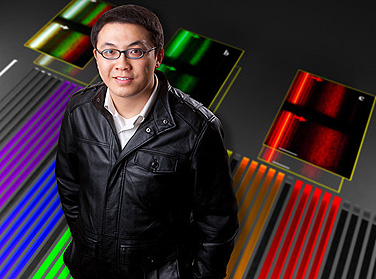News
Capturing the colors of the rainbow

New nanomaterials created by Qiaoqiang Gan allow for the trapping of different wavelengths of light, which could boost data storage and communications. Photo: DOUGLAS LEVERE
-
 Print
Print -
 Comments
Comments
-
“Light is usually very fast, but the structures I created can slow broadband light significantly. It’s as though I can hold the light in my hand.”
A UB electrical engineer, who as a graduate student at Lehigh University demonstrated experimentally the “rainbow-trapping effect,” a phenomenon that could boost optical data storage and communications, is now working to capture all the colors of the rainbow.
In a paper published last month in the Proceedings of the National Academy of Sciences, Qiaoqiang Gan (pronounced “chow-chung gone”), assistant professor of electrical engineering in the School of Engineering and Applied Sciences—and his former colleagues at Lehigh University working in the lab of faculty member Filbert Bartoli—described how they slowed broadband light waves using a type of material called nanoplasmonic structures.
They created nanoplasmonic structures by making nanoscale grooves in metallic surfaces at different depths, which alter the materials’ optical properties.
These plasmonic chips provide the critical connection between nanoelectronics and photonics, Gan explains, allowing these different types of devices to be integrated, a prerequisite for realizing the potential of optical computing, “lab-on-a-chip” biosensors and more efficient, thin-film photovoltaic materials.
According to Gan, the optical properties of the nanoplasmonic structures allow different wavelengths of light to be trapped at different positions in the structure, potentially allowing for optical data storage and enhanced nonlinear optics.
The structures Gan developed slow light down so much that they are able to trap multiple wavelengths of light on a single chip, whereas conventional methods can only trap a single wavelength in a narrow band.
“Light is usually very fast, but the structures I created can slow broadband light significantly,” says Gan. “It’s as though I can hold the light in my hand.”
That, Gan explains, is because of the structures’ engineered surface plasmon resonances, where light excites the waves of electrons that oscillate back and forth on metal surfaces.
In this case, he says, light can be slowed down and trapped in the vicinity of resonances in this novel, dispersive structural material.
Gan and his colleagues also found that because the nanoplasmonic structures they developed can trap very slow resonances of light, they can do so at room temperature instead of at the ultracold temperatures that are required in conventional slow-light technologies.
“In the PNAS paper, we showed that we trapped red to green,” explains Gan. “Now, we are working on trapping a broader wavelength—from red to blue. We want to trap the entire rainbow.”
Gan, who was hired at UB under the UB 2020 strategic strength Integrated Nanostructured Systems, will be working toward that goal, using the ultrafast light source in the laboratory of Alexander N. Cartwright, vice president for research and professor of electrical engineering.
“This ultrafast light source will allow us to measure experimentally just how slow is the light that we have trapped in our nanoplasmonic structures,” Gan explains. “Once we know that, we will be able to demonstrate our capability to manipulate light through experiments and optimize the structure to slow the light further.”
Gan notes that the ultimate goal is to achieve a breakthrough in optical communications called multiplexed, multiwavelength communications, where optical data can potentially be tamed at different wavelengths, thus greatly increasing processing and transmission capacity.
He points out that it is widely recognized that if light could ever be stopped entirely, new possibilities would open up for data storage.
“At the moment, processing data with optical signals is limited by how quickly the signal can be interpreted,” he says. “If the signal can be slowed, more information could be processed without overloading the system.”
Co-authors with Gan on the study are Filbert Bertoli, Yongkang Gao, Yujie Ding, Kyle Wagner and Dmitri Vezenov, all of Lehigh University.

Reader Comments